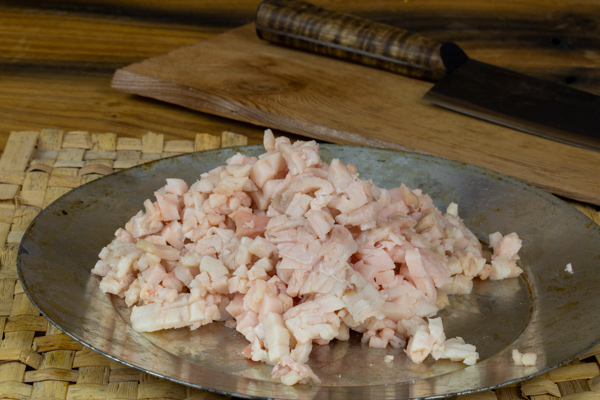Lewis’s Treat
Suet Dumplings
© 2020 by Kristopher K. Townsend. Permission to use granted under the Creative Commons Attribution-Share Alike 4.0 International license.
Lewis didn’t have a Le Crueset dutch oven like the one shown above, but no doubt the men complimented the chef, no matter how the dumplings tasted. He was, after all, not just the cook, but their captain.
During the last week of June 1805, the portage around the Great Falls of the Missouri was in full swing. On 26 June 1805, Toussaint Charbonneau—and likely Sacagawea—are rendering tallow at the lower portage camp. A crew at the upper portage camp gathers materials and sews skins for the soon-to-be launched iron-framed boat. After a long day hauling the fourth and fifth dugouts across the portage route where “the plain appear to be black with” bison, Whitehouse collapses from exhaustion—likely heatstroke or at the very least dehydration. It was on this day, that Lewis decided the men deserved a treat:
[T]o myself I assign the duty of cook . . . . boiled a large quantity of excellent dryed buffaloe meat and made each man a large suet dumpling by way of a treat.
Within the structure of the military mess system, having the highest-ranking officer cook for the men, was an unusual and magnanimous gesture. Lewis must have recognized and appreciated the team effort displayed by those under his command. Likely, everyone now sensed the portage would be successful, and that they would achieve their larger goal: finding the source of the Missouri River, crossing the Rocky Mountains, and paddling to the Pacific Ocean.
With so many buffalo in the area, there would be no shortage of suet, a high-quality fat from around the animal’s loins and kidneys. In baking, suet serves much the same purpose as today’s vegetable shortening. From this author’s experience, when making suet dough, the suet does not break down into the fine crumb structure the cook expects when cutting a dough made with modern shortening. By far, most of the labor in making suet dumplings is cutting the suet chunks into small squares.
Although flour supplies were minimal at this point in the journey, the real treat, perhaps from the enlisted men‘s perspective, was the labor Lewis gave to finely dice the suet. His act demonstrated several of the team-building leadership tenets outlined by Jack Uldrich:[1]Jack Uldrich, Into the Unknown: Leadership Lessons from Lewis and Clark’s Daring Westward Expedition (New York: American Management Association, 2004), 201–221.
- Lead by example
- Celebrate success
- Do the little things
The Recipe
½-pound Diced Beef Suet
© 2020 by Kristopher K. Townsend. Permission to use granted under the Creative Commons Attribution-Share Alike 4.0 International license.
Suet dumplings can be made with any day-to-day stew you choose. You don’t have to boil bison jerky as Lewis did. Whatever meat, vegetables, and seasonings you choose to include, be sure to appreciate that you have access to them. Beef suet is a good substitute for bison suet, but you will likely have to ask a grocery market butcher to hold some pieces of suet for you.
Leandra Zim Holland provides this recipe for suet dumplings:[2]Leandra Zim Holland, Feasting and Fasting with Lewis & Clark: A Food and Social History of the Early 1800s (Emigrant, Montana: Old Yellowstone Publishing, 2003), 45. Holland adapts and cites a … Continue reading
His [Lewis] “treats” were probably similar to the dumplings in this traditional recipe.
- ½ lb. suet
- 3 C. flour
- 1 tsp. salt
- 1 C. cold water
Finely dice suet, mix with flour and salt. Gradually add water until mixture forms a ball. Shape into 2″ dumpling balls. Place in stew and cook until done (approximately 25 minutes at a simmer)—makes a dozen dumplings.
More Cooking Experiences
- Jerking Meat
- Making Pemmican
- “Suet Dumplings” in Mary Gunderson, The Food Journal of Lewis & Clark: Recipes for an Expedition (Yankton, South Dakota: 2003).
Notes
| ↑1 | Jack Uldrich, Into the Unknown: Leadership Lessons from Lewis and Clark’s Daring Westward Expedition (New York: American Management Association, 2004), 201–221. |
|---|---|
| ↑2 | Leandra Zim Holland, Feasting and Fasting with Lewis & Clark: A Food and Social History of the Early 1800s (Emigrant, Montana: Old Yellowstone Publishing, 2003), 45. Holland adapts and cites a recipe by Leslie Mansfield, The Lewis & Clark Cookbook: Historic Recipes (Berkeley: Celestial Arts, 2002). |
Experience the Lewis and Clark Trail
The Lewis and Clark Trail Experience—our sister site at lewisandclark.travel—connects the world to people and places on the Lewis and Clark Trail.
Discover More
- The Lewis and Clark Expedition: Day by Day by Gary E. Moulton (University of Nebraska Press, 2018). The story in prose, 14 May 1804–23 September 1806.
- The Lewis and Clark Journals: An American Epic of Discovery (abridged) by Gary E. Moulton (University of Nebraska Press, 2003). Selected journal excerpts, 14 May 1804–23 September 1806.
- The Lewis and Clark Journals. by Gary E. Moulton (University of Nebraska Press, 1983–2001). The complete story in 13 volumes.



